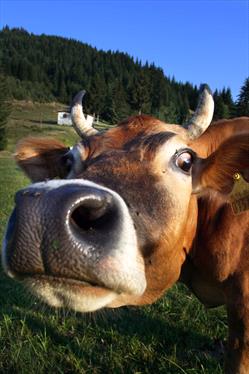Working with graduate students and researchers on their animal behavior projects is great fun because you get to learn so much about the animals, yet you don’t have the dread of writing and publishing the scientific paper—a task that somehow takes at least 10 times longer than the actual time it takes to collect data. Here’s one project I helped with in 1999 – 2000 when I was completing my Master’s in Animal Science (emphasis on animal behavior). The investigators were my major adviser, Dr. Ed Price, his graduate student, Jennipher Harris, and his research assistant, Reid Borgwardt.
Cows Prefer Togetherness
With beef cattle, animals spend most of their lives on the range and are handled primarily when it’s time for vaccinations and other health-related procedures. Because there’s safety in numbers, cows hang around in groups called herds. These herds are comprised of females and their offspring. Adult males usually hang out in bachelor herds away from the female herds except when females are in heat.
How Do Males Know When Females Are in Heat?
Females in heat welcome males. (Hubba, hubba!) Bulls know when females are in heat because females release chemical signals called pheromones through their urine into the environment. A bull can detect these pheromones when he sniffs the fluid and then deposits it into an area in the roof of his mouth called the vomeronasal organ. The bull makes a face (called the flehman response) when it’s transferring the chemical to its vomeronasal organ.
Females also mount each other when they are in heat or close to being in heat. Males can see this from a long distance away; this behavior attracts them to the cows. Of course, males mate with females, which results in the birth of a calf and here our story begins.
Cow and Calf Bond within Minutes of Birth
Cows give birth approximately 9 to10 months after conception. Within minutes of giving birth, the cow bonds closely to her calf who is usually up and walking within one hour and running within 24 hours. These hungry calves need lots of their mother’s milk to grow but they don’t nurse all day. Rather, they nurse in bouts several times a day. The first bout is soon after they wake up in the morning. Then, while their mothers wander across the field to collect food in the form of grass, the youngsters remain in one spot. They’re still protected because a few adult cows stay back to babysit. Occasionally, throughout the day, a calf will moo for its mother. Its mother will call back and then head for its calf. Usually, soon thereafter, other calves and their mothers will call to each other, and, before long, the whole herd is nursing.
By six months of age, calves are still nursing but are getting a large percentage of their nutrients from grazing. The standard practice is to wean calves from their mothers abruptly at this age, by physically separating calf and mother. Such abrupt weaning through physical separation may stress both mother and calf. Does this stress affect the calf and, if so, how? In the wild calves would self-wean gradually at about 9 to 13 months of age.
Why Do the Study and What Did It Find?
The purpose of this research project was to determine whether a difference in stress and growth occurred between calves weaned across a fenceline [but still could have contact with their mothers] vs. calves weaned completely separated from their mothers. Cows and calves were broken into three groups—a control group where they were not separated, an experimental group where they were separated by a fenceline barrier, and a second experimental group where the cows were placed on a truck and driven to a location away from the calves. We measured what cows and calves were doing each minute so that we could compare differences in behavior. We also measured the weight of calves in each group at the end of the project.
The findings were pretty obvious. The study found that calves weaned away from their mothers showed more stress behaviors—they vocalized more frequently, ate less, and spent much more time walking than the calves weaned with just a fence separating them from their mothers. Fenceline weaned calves spent the first several days close to the fence but thereafter rapidly increased their distance from the fence. They were completely weaned within five days. Additionally, these calves gained more weight than calves that were abruptly weaned. After 10 weeks, fenceline calves had gained an average of 31% more weight than the average calf weaned through physical separation from its mother.
The verdict? Clearly, fenceline weaning results in less stress as well as greater weight gain than weaning through complete separation.



